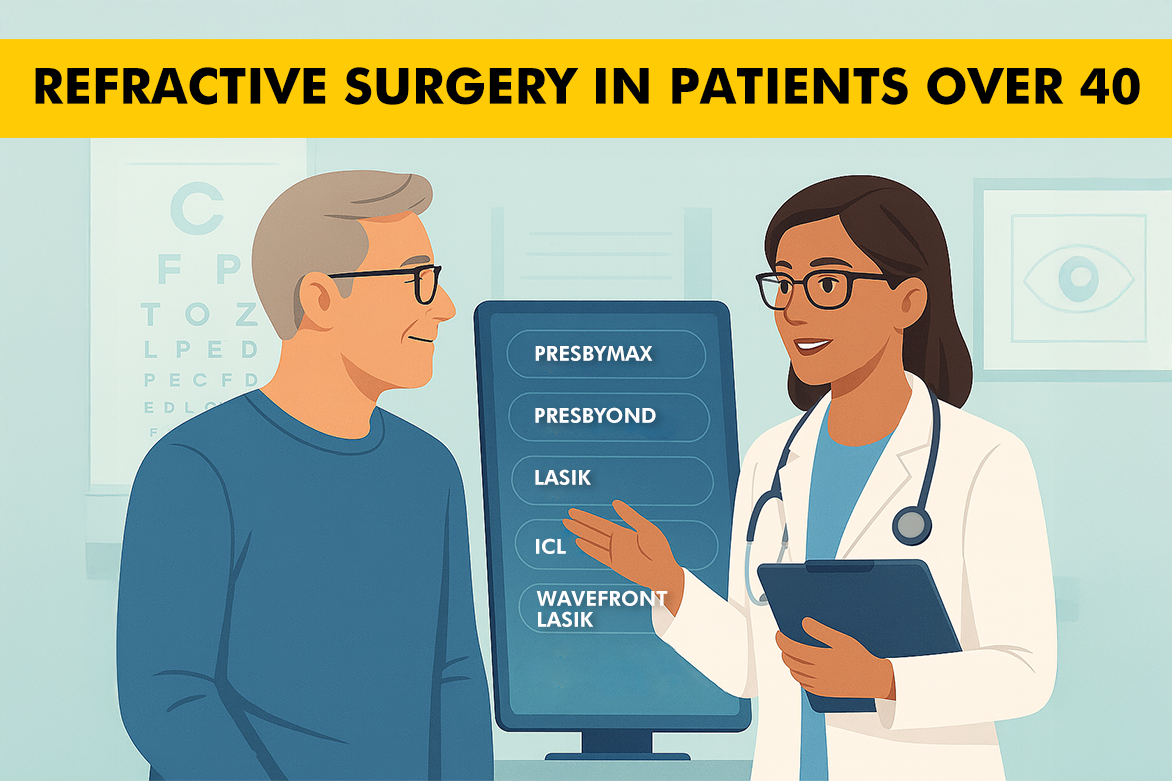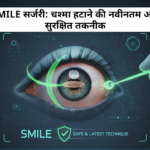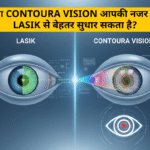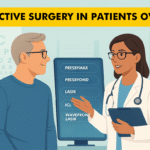Table of Contents
- Why Vision Changes After 40
- Understanding Presbyopia Correction
- Surgical Options for Vision After 40
- Benefits of Presbyopia Correction Surgery
- Recovery Expectations and Follow-Up
- Am I a Good Candidate After 40?
- Risks and Limitations to Consider
- Choosing the Right Approach
- Conclusion
- Frequently Asked Questions (FAQs)
Hitting 40 and suddenly your phone needs to be at arm’s length to read? You’re squinting at restaurant menus in dim light? Welcome to the club nobody wants to join.
That moment when you realize you need reading glasses hits hard. One day you’re fine, the next you’re holding everything farther away. It’s like your eyes just decided to age overnight.
But here’s the thing – you don’t have to surrender to reading glasses. Modern presbyopia correction surgery has come a long way. There are real solutions for vision after 40 that can give you back the visual freedom you thought was gone forever.
Let’s talk about what’s actually happening to your eyes and what you can do about it.
Why Vision Changes After 40
Your eyes aren’t broken. They’re just getting older. And with age comes presbyopia – the fancy term for “why can’t I read this tiny text anymore?”
Here’s what’s happening inside your eye. You’ve got a natural lens that’s been flexible your whole life. It changes shape to focus on things close up or far away. Think of it like the autofocus on a camera.
But after 40, that lens starts getting stiff. Like really stiff. It loses its ability to change shape easily. So when you try to focus on something close – your phone, a book, a menu – your lens can’t adjust properly anymore.
This isn’t about needing glasses for distance vision. That’s different. This is specifically about age-related surgery becoming necessary because your near vision is shot.
Common presbyopia symptoms:
- Holding books and phones at arm’s length
- Needing brighter light to read
- Eye strain after close-up work
- Headaches from squinting
- Difficulty switching focus between near and far
The frustrating part? This happens to literally everyone. Perfect vision your whole life? Doesn’t matter. Presbyopia comes for us all.
Understanding Presbyopia Correction
Presbyopia correction isn’t your grandfather’s eye surgery. We’re not talking about basic LASIK that just fixes distance vision. This is specialized presbyopia correction surgery designed specifically for the over-40 crowd.
Traditional LASIK reshapes your cornea to fix nearsightedness, farsightedness, or astigmatism. Great for distance vision. But it doesn’t solve the lens stiffness problem that causes presbyopia.
Modern presbyopia correction surgery takes a different approach. Instead of just fixing one type of vision, these procedures aim to give you clear sight at multiple distances. Near, far, and everything in between.
The goal isn’t just ditching reading glasses. It’s restoring the visual flexibility you had in your twenties and thirties. Being able to read your phone, work on a computer, drive at night, and see across a room – all without constantly switching glasses.
This represents a fundamental shift in how we think about presbyopia correction treatment after 40. We’re not just managing presbyopia anymore. We’re actually correcting it.
Surgical Options for Vision After 40
Good for you reader, you now have options. Options that will enhance your sight and change the way you view the world.
PresbyLASIK: Advanced Corneal Reshaping
PresbyLASIK takes traditional LASIK and adds presbyopia correction to the mix. Your surgeon reshapes your cornea to create different zones – one for distance vision, one for near vision.
How it works: Think of it like progressive lenses built right into your cornea. The center handles close-up work. The outer areas manage distance vision. Your brain learns to use the right zone automatically.
Best for: People with mild to moderate presbyopia who want to avoid lens replacement surgery.
SMILE Surgery: Minimally Invasive Option
SMILE (Small Incision Lenticule Extraction) represents the latest advancement in laser vision correction. While primarily designed for myopia and astigmatism, emerging techniques are exploring its potential for presbyopia correction.
How it works: Creates a tiny 2-4mm incision instead of a full corneal flap. The laser reshapes corneal tissue from within, offering a gentler approach than traditional LASIK.
Advantages: Faster healing, reduced dry eye risk, and greater corneal stability. The minimally invasive nature appeals to patients concerned about traditional LASIK complications.
Current limitations: SMILE for presbyopia remains in development stages. Most presbyopia patients still benefit more from established techniques like RLE or PresbyLASIK.
Future potential: As technology advances, SMILE may become a preferred option for younger presbyopia patients seeking minimally invasive presbyopia correction surgery.
Corneal Inlays: The Minimalist Approach
Corneal inlays are tiny devices implanted in your cornea. Usually just in one eye. They create a small aperture effect that increases your depth of focus for reading.
The procedure: Quick outpatient surgery. The inlay goes into your non-dominant eye. Your dominant eye handles distance vision. Together, they give you functional vision at all distances.
Reality check: This is typically the most reversible option if you’re not happy with results.
Refractive Lens Exchange (RLE): The Gold Standard
RLE replaces your natural lens with an artificial one designed for multiple distances. It’s like cataract surgery, but you’re doing it before cataracts develop.
Why it works so well: You’re literally replacing the stiff lens that’s causing presbyopia. The new lens can be multifocal, giving you clear vision at all distances.
Long-term benefits: This presbyopia correction procedure also prevents cataracts since you no longer have a natural lens to develop them.
Presbyond/Blended Vision LASIK
Blended vision corrects one eye slightly for distance, the other slightly for near. But not as dramatically as traditional monovision. The difference is subtle enough that your brain blends the images naturally.
The advantage: Less adaptation time than traditional monovision. Better depth perception. More natural feeling vision.
Each option has its place. Your lifestyle, prescription, and eye health determine which presbyopia correction procedure works best for you.
Benefits of Presbyopia Correction Surgery
The presbyopia correction benefits go way beyond just seeing clearly. We’re talking about life-changing improvements in how you function daily.
Freedom from Constant Glasses
No more digging through your bag for reading glasses. No more having three pairs scattered around your house. No more squinting at your phone because you left your glasses in the car.
Real-world freedom: Reading restaurant menus without asking for help. Checking your phone in bed without reaching for glasses. Working on your computer all day without eye strain.
Improved Quality of Life
Professional benefits: Better performance in jobs requiring close-up work. No more struggling during presentations or meetings. Increased confidence in professional settings.
Personal benefits: Enjoying hobbies again – reading, crafts, cooking without frustration. Better safety while driving, especially at night.
Long-lasting Results
Unlike reading glasses that need constant updating, surgical presbyopia correction provides stable, long-term results. Most procedures last for decades.
The confidence factor: Knowing your vision won’t suddenly fail you during important moments. Travel becomes easier. Activities become more spontaneous.
Active Lifestyle Support
Sports and exercise become more enjoyable. No glasses sliding down during workouts. No worrying about breaking expensive progressive lenses.
Swimming, cycling, running – all become more convenient when you’re not dependent on corrective eyewear.
Recovery Expectations and Follow-Up
Presbyopia correction recovery varies by procedure, but most patients are pleasantly surprised by how quickly they bounce back.
Immediate Recovery (First Few Days)
RLE patients: Vision often improves within hours. Some blurriness is normal as your eye heals. Most people return to work within 2-3 days.
LASIK-based procedures: Initial healing happens fast. You might notice improvement the same day, though vision continues stabilizing for weeks.
Corneal inlay patients: Adaptation takes a bit longer. Your brain needs time to learn how to use the new visual system effectively.
Full Adaptation (Weeks to Months)
Here’s the thing about presbyopia surgery – your brain needs training time. You’re essentially learning a new way to see.
Weeks 1-4: Vision continues improving. Your brain adapts to using different zones or the new lens. Reading becomes more natural.
Months 1-3: Full adaptation usually complete. Most patients report complete satisfaction with their vision by this point.
Follow-up schedule: Regular check-ups ensure proper healing. Your surgeon monitors vision quality and makes adjustments if needed.
What to Expect During Healing
Normal experiences: Some glare or halos around lights initially. Slight vision fluctuation as your eye heals. Mild dryness that responds well to drops.
Red flags: Severe pain, sudden vision loss, or signs of infection require immediate attention.
Most patients describe presbyopia correction recovery as easier than they expected. The hardest part is often remembering you don’t need reading glasses anymore.
Am I a Good Candidate After 40?
Not everyone qualifies for presbyopia correction surgery. But more people are candidates than you might think.
Essential Requirements
Overall eye health comes first. No active infections, severe dry eye, or untreated glaucoma. Your corneas need to be healthy and thick enough for laser procedures.
Realistic expectations matter enormously. Surgery dramatically improves vision, but perfect sight at every distance isn’t always achievable.
Stable prescription for at least a year. Your eyes need to be changed before surgery makes sense.
Lifestyle Considerations
Your daily visual demands influence which procedure works best. Office workers might benefit from different approaches than manual laborers.
Hobbies and activities matter too. Avid readers might prefer RLE. Athletes might choose LASIK-based options.
Professional requirements: Pilots, surgeons, and others with critical vision needs require specialized evaluation.
Age-Related Factors
Early 40s: More surgical options available. Natural lens still relatively healthy.
50s and beyond: RLE often becomes the preferred choice. Prevents future cataract surgery.
Dry eye considerations: Common after 40. Manageable but needs evaluation before surgery.
Health Factors
Diabetes: Well-controlled diabetes doesn’t disqualify you, but requires careful monitoring.
Autoimmune conditions: May affect healing. Require individual assessment.
Medications: Some drugs affect healing or vision. Full disclosure to your surgeon is essential.
Risks and Limitations to Consider
Every surgery has risks. Presbyopia correction is generally safe, but understanding potential downsides helps you make informed decisions.
Common Side Effects
Halos and glare around lights, especially during initial healing. Most patients adapt within weeks, though some experience ongoing challenges with night driving.
Depth perception shifts occur with monovision techniques. Your brain typically adjusts within 1-3 months, restoring natural depth awareness.
Dry eye symptoms may temporarily worsen post-surgery. Manageable with prescribed drops and usually resolves as healing progresses.
Realistic Outcome Expectations
Complete glasses freedom isn’t guaranteed for everyone. While most patients dramatically reduce glasses dependence, certain situations like fine print reading may still require occasional assistance.
Individual healing varies significantly. Your friend’s perfect results don’t guarantee identical outcomes for you. Age, eye health, and lifestyle factors influence results.
Fine-tuning is sometimes necessary. Modern techniques boast high success rates, but approximately 5-10% of patients benefit from minor adjustments or enhancement procedures.
Long-term Considerations
Technology keeps advancing. Today’s cutting-edge procedures will eventually be replaced by even more sophisticated options within the next decade.
Natural aging continues. Surgery addresses current presbyopia but won’t prevent future age-related changes like cataracts or macular degeneration.
Financial investment required. Procedures cost ₹40,000-150,000 per eye in India. Insurance coverage remains limited, making this a significant out-of-pocket expense for most patients.
The bottom line: Understanding these limitations upfront prevents unrealistic expectations and helps you choose the right procedure, timing and approach for your unique situation.
Choosing the Right Approach
Personalized presbyopia correction treatment is everything in presbyopia correction. Cookie-cutter approaches don’t work.
Your surgeon should spend significant time understanding your lifestyle, visual demands, and expectations. The best procedure for you depends on factors unique to your situation.
Questions to discuss:
- What are your most important visual activities?
- How much glasses dependence can you accept?
- What’s your comfort level with newer vs. established procedures?
- How do cost and insurance coverage factor into your decision?
Conclusion
Vision correction after 40 isn’t just possible – it’s remarkably advanced. The days of simply accepting presbyopia and reaching for reading glasses are over.
Modern presbyopia correction surgery offers genuine solutions for the visual challenges that come with age. Whether it’s RLE, blended LASIK, or corneal inlays, there’s likely an approach that fits your lifestyle and goals.
The key is finding an experienced surgeon who understands presbyopia correction and takes time to match the right procedure to your specific needs. Don’t settle for “just getting older” when surgical solutions can restore the visual freedom you thought was gone forever.
Your vision after 40 can be better than you imagine. The technology exists. The expertise is available. The only question is whether you’re ready to explore what’s possible.
Ready to learn more about your options? Schedule a consultation with a presbyopia specialist. Your future self will thank you for taking action instead of just accepting visual limitations.





